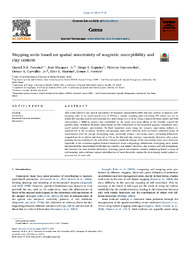Mapping units based on spatial uncertainty of magnetic susceptibility and clay content.
Mapping units based on spatial uncertainty of magnetic susceptibility and clay content.
Autoria: TEIXEIRA, D. D. B.; MARQUES JUNIOR, J.; SIQUEIRA, D. S.; VASCONCELOS, V.; CARVALHO JUNIOR, O. A.; MARTINS, E. de S.; PEREIRA, G. T.
Resumo: This study aimed to use spatial uncertainty of magnetic susceptibility (MS) and clay content to improve soil- mapping units. In an experimental area of 870 ha, a regular sampling grid containing 371 points was set, in which MS and clay content were assessed at a depth range of 0–0.25 m. Using a digital elevation model and field observations, a 4440-m transect was established on the study area from hilltop to the foothill, toward the gentlest slope. Standard deviation maps based on 200 realizations of the sequential gaussian simulation mea- sured spatial estimate uncertainties. To limit transition zones along the transect, uncertainty isolines re- presentative of the transition between soil-mapping units were selected. Both attributes presented peaks of uncertainties near the change of mapping units, previously known. Uncertainty zones, previously delineated, ranged from 45 to 210 m and from 60 to 170 m, for MS and clay content, respectively. However, after extra- polating the uncertainties to the side of the transect, amplitude changes of the uncertainty zones were observed, especially in the transition regions between landscape shape and geology. Delineation of mapping units, which incorporated the uncertainties of MS and clay content, was similar. However, due to lower cost and promptness, MS becomes the most feasible alternative. Knowing spatial uncertainties enables readjusting limits in maps of soil-mapping units and may support identification of most favorable regions for determining modal pedon re- presentative of each unit.
Ano de publicação: 2018
Tipo de publicação: Artigo de periódico
Unidade: Embrapa Cerrados
Palavras-chave: Geoestatística, Mapeamento do solo, Pedologia, Pedometria
Observações
1 - Por padrão são exibidas publicações dos últimos 20 anos. Para encontrar publicações mais antigas, configure o filtro ano de publicação, colocando o ano a partir do qual você deseja encontrar publicações. O filtro está na coluna da esquerda na busca acima.
2 - Para ler algumas publicações da Embrapa (apenas as que estão em formato ePub), é necessário ter, no celular ou computador, um desses softwares gratuitos. Sistemas Android: Google Play Livros; IOS: iBooks; Windows e Linux: software Calibre.
Acesse outras publicações
Acesse a Base de Dados da Pesquisa Agropecuária (BDPA) para consultar o acervo completo das bibliotecas da Embrapa.

